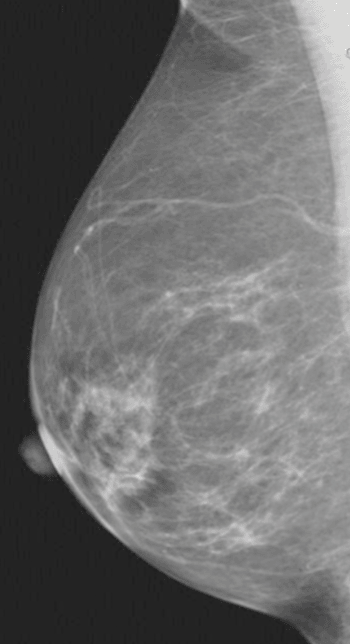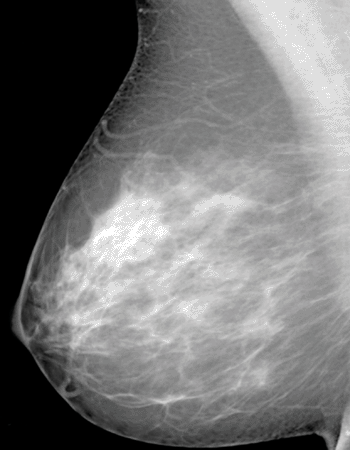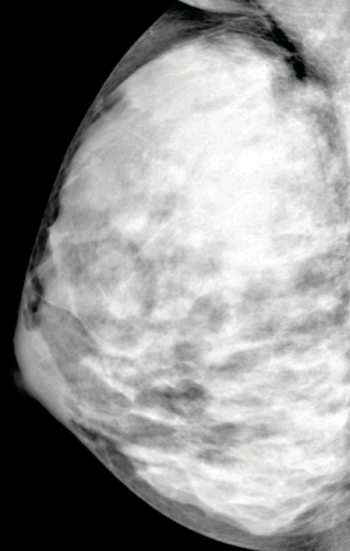Breast Cancer Risk Linked to Breast Density Alterations as Women Age
|
By MedImaging International staff writers Posted on 01 Jan 2014 |

Image: Fatty breast tissue (Photo courtesy of RSNA).

Image: Scattered density breast tissue (Photo courtesy of RSNA).

Image: Extremely dense breast tissue (Photo courtesy of RSNA).
Automated breast density measurement is predictive of breast cancer risk in younger women, and that risk may be associated with the rate at which breast density changes in some women as they age, according to recent research.
The findings were presented December 3, 2013, at the annual meeting of the Radiological Society of North America (RSNA), held in Chicago (IL, USA). Breast density, as determined by mammography, has been known to be a strong and independent risk factor for breast cancer. The American Cancer Society (ACS) considers women with very dense breasts to be at moderately increased risk of cancer, and recommends they talk to their physicians about adding magnetic resonance imaging (MRI) scanning to their annual mammograms.
“Women under age 50 are most at risk from density-associated breast cancer, and breast cancer in younger women is frequently of a more aggressive type, with larger tumors and a higher risk of recurrence,” said the study’s senior author, Nicholas Perry, MBBS, FRCS, FRCR, director of the London Breast Institute (London, UK).
Dr. Perry and colleagues, for the new study, compared breast density and cancer risk between younger and older women and analyzed how the risk relates to changes in breast density over time. The study group included 282 breast cancer cases and 317 healthy control study participants who underwent full-field digital mammography (FFDM), with breast density measured separately using an automated volumetric system.
“In general, we refer to breast density as being determined by mammographic appearance, and that has, by and large, in the past been done by visual estimation by the radiologist—in other words, subjective and qualitative,” Dr. Perry said. “The automated system we used in the study is an algorithm that can be automatically and easily applied to a digital mammogram, which allows an objective and, therefore, quantitative density measurement that is reproducible.”
Breast cancer patients showed higher mammographic density than healthy participants up to the age of 50. The healthy controls demonstrated a significant decline in density with age following a linear pattern, while there was considerably more variability in density regression among the breast cancer patients. “The results are interesting, because there would appear to be some form of different biological density mechanism for normal breasts compared to breasts with cancer, and this appears to be most obvious for younger women,” Dr. Perry said. “This is not likely to diminish the current ACS guidelines in any way, but it might add a new facet regarding the possibility of an early mammogram to establish an obvious risk factor, which may then lead to enhanced screening for those women with the densest breasts.”
Some women, for example, might undergo a modified exposure exam at age 35 to establish breast density levels, Dr. Perry noted. Those with denser breast tissue could then be followed more closely with mammography and additional imaging such as an MRI scan or ultrasound for earlier cancer detection and treatment.
“It has been estimated that about 40% of life years lost to breast cancer are from women under 50 diagnosed outside of screening programs,” Dr. Perry concluded. “In my practice, which is largely composed of urban professional women, 40% of cancers year to year are diagnosed in women under 50, and 10% in women younger than 40.”
Related Links:
London Breast Institute
The findings were presented December 3, 2013, at the annual meeting of the Radiological Society of North America (RSNA), held in Chicago (IL, USA). Breast density, as determined by mammography, has been known to be a strong and independent risk factor for breast cancer. The American Cancer Society (ACS) considers women with very dense breasts to be at moderately increased risk of cancer, and recommends they talk to their physicians about adding magnetic resonance imaging (MRI) scanning to their annual mammograms.
“Women under age 50 are most at risk from density-associated breast cancer, and breast cancer in younger women is frequently of a more aggressive type, with larger tumors and a higher risk of recurrence,” said the study’s senior author, Nicholas Perry, MBBS, FRCS, FRCR, director of the London Breast Institute (London, UK).
Dr. Perry and colleagues, for the new study, compared breast density and cancer risk between younger and older women and analyzed how the risk relates to changes in breast density over time. The study group included 282 breast cancer cases and 317 healthy control study participants who underwent full-field digital mammography (FFDM), with breast density measured separately using an automated volumetric system.
“In general, we refer to breast density as being determined by mammographic appearance, and that has, by and large, in the past been done by visual estimation by the radiologist—in other words, subjective and qualitative,” Dr. Perry said. “The automated system we used in the study is an algorithm that can be automatically and easily applied to a digital mammogram, which allows an objective and, therefore, quantitative density measurement that is reproducible.”
Breast cancer patients showed higher mammographic density than healthy participants up to the age of 50. The healthy controls demonstrated a significant decline in density with age following a linear pattern, while there was considerably more variability in density regression among the breast cancer patients. “The results are interesting, because there would appear to be some form of different biological density mechanism for normal breasts compared to breasts with cancer, and this appears to be most obvious for younger women,” Dr. Perry said. “This is not likely to diminish the current ACS guidelines in any way, but it might add a new facet regarding the possibility of an early mammogram to establish an obvious risk factor, which may then lead to enhanced screening for those women with the densest breasts.”
Some women, for example, might undergo a modified exposure exam at age 35 to establish breast density levels, Dr. Perry noted. Those with denser breast tissue could then be followed more closely with mammography and additional imaging such as an MRI scan or ultrasound for earlier cancer detection and treatment.
“It has been estimated that about 40% of life years lost to breast cancer are from women under 50 diagnosed outside of screening programs,” Dr. Perry concluded. “In my practice, which is largely composed of urban professional women, 40% of cancers year to year are diagnosed in women under 50, and 10% in women younger than 40.”
Related Links:
London Breast Institute
Latest Radiography News
- Novel Breast Imaging System Proves As Effective As Mammography
- AI Assistance Improves Breast-Cancer Screening by Reducing False Positives
- AI Could Boost Clinical Adoption of Chest DDR
- 3D Mammography Almost Halves Breast Cancer Incidence between Two Screening Tests
- AI Model Predicts 5-Year Breast Cancer Risk from Mammograms
- Deep Learning Framework Detects Fractures in X-Ray Images With 99% Accuracy
- Direct AI-Based Medical X-Ray Imaging System a Paradigm-Shift from Conventional DR and CT
- Chest X-Ray AI Solution Automatically Identifies, Categorizes and Highlights Suspicious Areas
- AI Diagnoses Wrist Fractures As Well As Radiologists
- Annual Mammography Beginning At 40 Cuts Breast Cancer Mortality By 42%
- 3D Human GPS Powered By Light Paves Way for Radiation-Free Minimally-Invasive Surgery
- Novel AI Technology to Revolutionize Cancer Detection in Dense Breasts
- AI Solution Provides Radiologists with 'Second Pair' Of Eyes to Detect Breast Cancers
- AI Helps General Radiologists Achieve Specialist-Level Performance in Interpreting Mammograms
- Novel Imaging Technique Could Transform Breast Cancer Detection
- Computer Program Combines AI and Heat-Imaging Technology for Early Breast Cancer Detection
Channels
MRI
view channel
World's First Sensor Detects Errors in MRI Scans Using Laser Light and Gas
MRI scanners are daily tools for doctors and healthcare professionals, providing unparalleled 3D imaging of the brain, vital organs, and soft tissues, far surpassing other imaging technologies in quality.... Read more
Diamond Dust Could Offer New Contrast Agent Option for Future MRI Scans
Gadolinium, a heavy metal used for over three decades as a contrast agent in medical imaging, enhances the clarity of MRI scans by highlighting affected areas. Despite its utility, gadolinium not only... Read more.jpg)
Combining MRI with PSA Testing Improves Clinical Outcomes for Prostate Cancer Patients
Prostate cancer is a leading health concern globally, consistently being one of the most common types of cancer among men and a major cause of cancer-related deaths. In the United States, it is the most... Read moreUltrasound
view channel
Largest Model Trained On Echocardiography Images Assesses Heart Structure and Function
Foundation models represent an exciting frontier in generative artificial intelligence (AI), yet many lack the specialized medical data needed to make them applicable in healthcare settings.... Read more.jpg)
Groundbreaking Technology Enables Precise, Automatic Measurement of Peripheral Blood Vessels
The current standard of care of using angiographic information is often inadequate for accurately assessing vessel size in the estimated 20 million people in the U.S. who suffer from peripheral vascular disease.... Read more
Deep Learning Advances Super-Resolution Ultrasound Imaging
Ultrasound localization microscopy (ULM) is an advanced imaging technique that offers high-resolution visualization of microvascular structures. It employs microbubbles, FDA-approved contrast agents, injected... Read more
Novel Ultrasound-Launched Targeted Nanoparticle Eliminates Biofilm and Bacterial Infection
Biofilms, formed by bacteria aggregating into dense communities for protection against harsh environmental conditions, are a significant contributor to various infectious diseases. Biofilms frequently... Read moreNuclear Medicine
view channel
New Imaging Technique Monitors Inflammation Disorders without Radiation Exposure
Imaging inflammation using traditional radiological techniques presents significant challenges, including radiation exposure, poor image quality, high costs, and invasive procedures. Now, new contrast... Read more
New SPECT/CT Technique Could Change Imaging Practices and Increase Patient Access
The development of lead-212 (212Pb)-PSMA–based targeted alpha therapy (TAT) is garnering significant interest in treating patients with metastatic castration-resistant prostate cancer. The imaging of 212Pb,... Read moreNew Radiotheranostic System Detects and Treats Ovarian Cancer Noninvasively
Ovarian cancer is the most lethal gynecological cancer, with less than a 30% five-year survival rate for those diagnosed in late stages. Despite surgery and platinum-based chemotherapy being the standard... Read more
AI System Automatically and Reliably Detects Cardiac Amyloidosis Using Scintigraphy Imaging
Cardiac amyloidosis, a condition characterized by the buildup of abnormal protein deposits (amyloids) in the heart muscle, severely affects heart function and can lead to heart failure or death without... Read moreGeneral/Advanced Imaging
view channel
PET Scans Reveal Hidden Inflammation in Multiple Sclerosis Patients
A key challenge for clinicians treating patients with multiple sclerosis (MS) is that after a certain amount of time, they continue to worsen even though their MRIs show no change. A new study has now... Read more
Artificial Intelligence Evaluates Cardiovascular Risk from CT Scans
Chest computed tomography (CT) is a common diagnostic tool, with approximately 15 million scans conducted each year in the United States, though many are underutilized or not fully explored.... Read more
New AI Method Captures Uncertainty in Medical Images
In the field of biomedicine, segmentation is the process of annotating pixels from an important structure in medical images, such as organs or cells. Artificial Intelligence (AI) models are utilized to... Read more.jpg)
CT Coronary Angiography Reduces Need for Invasive Tests to Diagnose Coronary Artery Disease
Coronary artery disease (CAD), one of the leading causes of death worldwide, involves the narrowing of coronary arteries due to atherosclerosis, resulting in insufficient blood flow to the heart muscle.... Read moreImaging IT
view channel
New Google Cloud Medical Imaging Suite Makes Imaging Healthcare Data More Accessible
Medical imaging is a critical tool used to diagnose patients, and there are billions of medical images scanned globally each year. Imaging data accounts for about 90% of all healthcare data1 and, until... Read more
Global AI in Medical Diagnostics Market to Be Driven by Demand for Image Recognition in Radiology
The global artificial intelligence (AI) in medical diagnostics market is expanding with early disease detection being one of its key applications and image recognition becoming a compelling consumer proposition... Read moreIndustry News
view channel
Bayer and Google Partner on New AI Product for Radiologists
Medical imaging data comprises around 90% of all healthcare data, and it is a highly complex and rich clinical data modality and serves as a vital tool for diagnosing patients. Each year, billions of medical... Read more
















